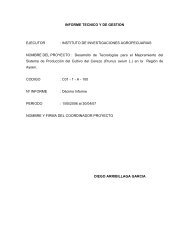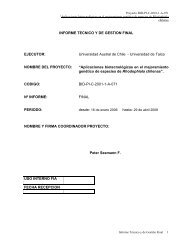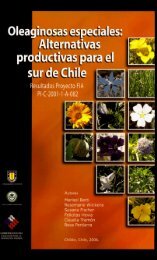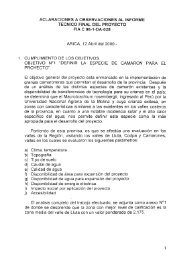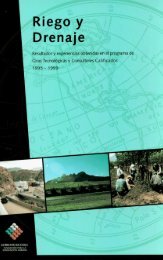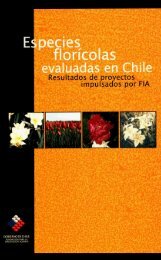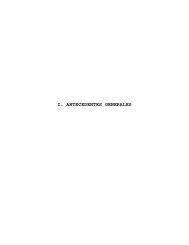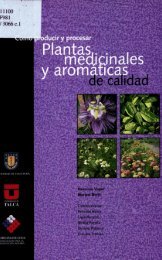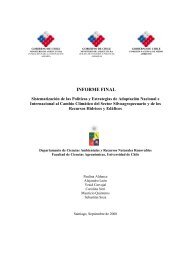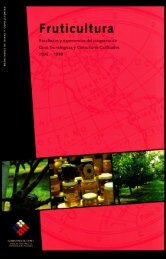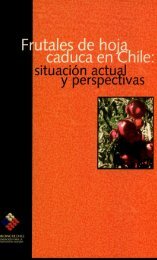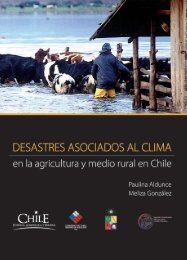Los residuos agrÃcolas y su uso en la alimentación de rumiantes
Los residuos agrÃcolas y su uso en la alimentación de rumiantes
Los residuos agrÃcolas y su uso en la alimentación de rumiantes
Create successful ePaper yourself
Turn your PDF publications into a flip-book with our unique Google optimized e-Paper software.
10s RESIDUOS AGRiCOlAS Y SU US0 EN LA ALlMENTAClbN DE RUMIANTES / CapitUlO 1<br />
Cuadro 1.1<br />
Re<strong>la</strong>ciones utilizadas para <strong>de</strong>terminar <strong>la</strong> cantidad <strong>de</strong> <strong>residuos</strong> <strong>en</strong> base al r<strong>en</strong>dimi<strong>en</strong>to<br />
<strong>de</strong>l grano <strong>en</strong> distintos cultivos (base materia seca)<br />
Cebada 1 9 2 0 0,72<br />
Av<strong>en</strong>a 1130 0,78<br />
C<strong>en</strong>t<strong>en</strong>o 2,00<br />
Sorgo 4300 2340<br />
Rakes y tubbrculos (frescos) 0,20 0,12<br />
Legumbres secas 4900 2,40<br />
Nueces y alm<strong>en</strong>dras 2,00 1120<br />
Oleaginosas 4,00 2,40<br />
Hortalizas frescas 0,25 0,15<br />
Frutas y bayas frescas Of40 0,24<br />
’ Cuoci<strong>en</strong>te <strong>en</strong>tre <strong>la</strong> produccibn <strong>de</strong> residuo vegetal y <strong>la</strong> producci6n <strong>de</strong> producto dtil.<br />
* Cuoci<strong>en</strong>te <strong>en</strong>tre <strong>la</strong> producci6n <strong>de</strong> forraje cosechable y <strong>la</strong> producci6n <strong>de</strong> producto dtil.<br />
Fu<strong>en</strong>te: Kossi<strong>la</strong> (1984).<br />
I<br />
De acuerdo con estas re<strong>la</strong>ciones, <strong>en</strong> Chile <strong>la</strong> cantidad <strong>de</strong> paja prov<strong>en</strong>i<strong>en</strong>te <strong>de</strong> cultivos <strong>de</strong><br />
cereales y legumbres, segljn <strong>la</strong> <strong>su</strong>perficie cultivada <strong>en</strong> 1997, seria <strong>de</strong> 3.000.000 <strong>de</strong> tone<strong>la</strong>das<br />
<strong>de</strong> materia seca, <strong>de</strong> <strong>la</strong>s cuales 1.800.000 tone<strong>la</strong>das estarian disponibles para us0 <strong>en</strong><br />
produccibn animal, <strong>la</strong>s que se distribuy<strong>en</strong> <strong>en</strong>tre <strong>la</strong> VI y X Regi6n. De esta cantidad el<br />
mayor porc<strong>en</strong>taje correspon<strong>de</strong> a paja <strong>de</strong> trigo, que repres<strong>en</strong>taria un E%, equival<strong>en</strong>te a<br />
1.188.000 tone<strong>la</strong>das. Estos vollim<strong>en</strong>es <strong>de</strong> forraje, limitados por <strong>su</strong> valor nutritivo y<br />
aceptabilidad por 10s animales, equivaldrian <strong>en</strong> terminos <strong>de</strong> materia seca a <strong>la</strong> producci6n<br />
anual <strong>de</strong> 225.000 hectareas <strong>de</strong> pra<strong>de</strong>ra, con r<strong>en</strong>dimi<strong>en</strong>tos anuales <strong>de</strong> 8,O tone<strong>la</strong>das<br />
<strong>de</strong> materia seca por hectarea, cifras que son figurativas por <strong>la</strong> gran difer<strong>en</strong>cia <strong>en</strong>tre estos<br />
recursos (Klee, 1992). Si el total se utilizara <strong>en</strong> producci6n animal, permitiria <strong>la</strong> man-<br />
t<strong>en</strong>cibn pot<strong>en</strong>cial <strong>de</strong> 328.000 vacunos <strong>de</strong> 500 kilos <strong>de</strong> peso vivo, durante un aRo<br />
b<br />
W<br />
Figura 1.1 Residuo <strong>de</strong>l cultivo <strong>de</strong> trigo<br />
Figura . .- Fardos <strong>de</strong> paja antes <strong>de</strong>l picado<br />
y tratami<strong>en</strong>to qulmico<br />
29




